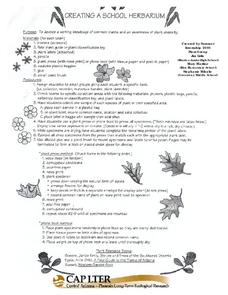Curated OER
AP: Chapter 29 and 30: Plant Diversity
It's a jungle out there! That is because of the tremendous diversity among plants. In this AP biology assignment, botanists answer questions about plant evolution, diversity, and reproduction. They differentiate between monocots and...
Curated OER
Ecology
Students explore, experience and experiment identifying the human impact on the environment of vegetative differences within the same biome. They assess what causes deserts, rain forests, savannahs, tundras and saguaros and how these...
Curated OER
Creating A School Herbarium
Young scholars create a school herbarium to develop a working assessment of common plants and become aware of plant diversity. They utilize pruners, a plant press, phone book, plant labels, a field plant guide and a classification key to...
Curated OER
Bugs in the Woods
Second graders identify insects and plants in the forest ecosystem in a structured field trip with stations and activity booklets. In this bugs instructional activity, 2nd graders explore the ecosystem of the forest, complete the...
Curated OER
Rx Rainforest:
Students identify plant diversity in the rainforest and the role that animals and habitats play in scientific research. They differentiate between natural habitat and laboratory research and work collaboratively to produce a video news...
Curated OER
Maintaining Plant Genebanks
Students examine the use, costs, and the need for plant gene banks. The rationale for gaining ownership over scientific information and the implications of the developing nations' reliance on biotechnology is explored in this...
Yale University
Yale New Haven Teachers Institute: Evolution of Plants
An extensive coverage of the evolutionary history of plants. Click on a topic in the outline and you'll go to a good discussion on this material.
Estrella Mountain Community College
Maricopa Community College: Nonvascular Plants and Nonseed Vascular Plants
Very detailed outline describing several aspects of plant diversity, including vascular vs. nonvascular, evolutionary adaptations, homosporous and heterosporous life cycles, and specific information on some ancient species (Lycophytes,...
Palomar Community College District
Wayne's Word: The Castor Bean: Plant Named After a Tick
A fascinating article on the natural history and biochemistry of castor oil. There are sections that are basic and descriptive as well as more technical information.
Other
Cartage.org: Nonvascular Plants and Nonseed Vascular Plants
This detailed resource focuses on tracheophytes, psilophytes pslophytes, lycophytes, equisetophytes, and ferns. Charts, drawings, and pictures supplement the text.
Texas A&M University
Texas A&m University: Plants and People Lab
Extensive lab has students fill out large chart of plant parts, "vegetables", with pictures with information about the scientific name, structure, and origin. Several wrap-up questions are also included to make generalizations about...
Annenberg Foundation
Annenberg Learner: The Habitable Planet: Unit 9: Biodiversity Decline
This is an extensive learning module on biodiversity and its decline. It looks at ways biodiversity is threatened, the possibility of another mass extinction, the causes and consequences of habitat loss, factors that drive biodiversity...
E-learning for Kids
E Learning for Kids: Science: Caribbean Sea: How Can We Classify Plants?
Aaylah is learning how to group some plants. Help her identify different types of plants.
Royal Botanic Gardens
Plant Cultures: Marigolds
This comprehensive resource examines the plant profile, history, spiritual uses, production and trade, medicinal properties, and food uses of the marigold.
Royal Botanic Gardens
Plant Cultures: Cardamom
Did you know that cardamom is the third most expensive spice in the world? Learn more about this interesting plant as you delve into the history, production, medicinal properties and more.
Royal Botanic Gardens
Plant Cultures: Ginger
This comprehensive resource discusses the history, production, trade, medicinal properties and uses of ginger in food.
Royal Botanic Gardens
Plant Cultures: Hemp
Plant profile, history, production & trade, traditional medicine, western medicine, drug, food, and crafts are the key topics explored in this thorough resource.
Royal Botanic Gardens
Plant Cultures: Tea
This resource provides information about the tea plant, including its history, production, trade, medicinal properties and more.
Science Education Resource Center at Carleton College
Serc: Investigating Simple Plants
Students will gather moss from the schoolyard, and observe it carefully, documenting their observations in their science notebooks. They will develop an investigable question from their observations, design and run an investigation on...
Science Education Resource Center at Carleton College
Serc: Using Plant Surveys to Study Biodiversity
An extended field investigation intended as launch into several concepts in environmental science including biodiversity, human impacts on natural systems, and energy transfer in ecosystems.
Royal Botanic Gardens
Plant Cultures: Betelnut
This comprehensive resource delves into betelnut history, spiritual significance, production, trade, and more. Interesting pictures of the plant supplement the text.
Royal Botanic Gardens
Plant Cultures: Garlic
Discover the many uses garlic has in the making of different foods and medicines as you peruse through this informative resource. You will be exposed to a detailed plant profile and history in addition to a number of interesting facts...
Royal Botanic Gardens
Plant Cultures: Henna
This complete resource examines the many uses of henna in medicine, cosmetics, dyes, perfumes and more. Interesting pictures supplement the text explanations.
Royal Botanic Gardens
Plant Cultures: Rice
Plant profile of rice. Covers history, spiritual, production and trade, traditional medicine, western medicine, food, crafts, cosmetics and other uses.















